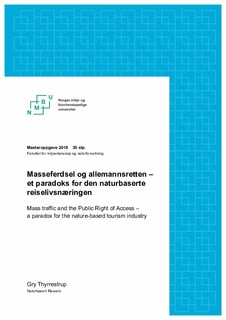| dc.contributor.advisor | Haukeland, Jan Vidar | |
| dc.contributor.author | Thyrrestrup, Gry | |
| dc.coverage.spatial | Norway | nb_NO |
| dc.date.accessioned | 2018-10-02T10:55:10Z | |
| dc.date.available | 2018-10-02T10:55:10Z | |
| dc.date.issued | 2018 | |
| dc.identifier.uri | http://hdl.handle.net/11250/2565769 | |
| dc.description.abstract | Naturbasert reiseliv er en næring i vekst, og stadig fler turister ønsker å oppleve norsk natur. I sommersesongene 2016 og 2017 har fler naturattraksjoner og destinasjoner i Norge opplevd en massiv økning i besøkstall. Enkelte attraksjoner har opplevd det man kan betegne som masseferdsel. Utviklingen utgjør et stort potensiale for den naturbaserte reiselivsnæringen, men har også medført noen utfordringer. Enkelte steder har masseferdselen medført negative konsekvenser i form av slitasje på naturverdiene og sikkerhetsmessige utfordringer. Dette har ført til en debatt i reiselivet om hvorvidt man bør regulere i allemannsretten for å imøtekomme forvaltningens utfordringer.
Denne studien undersøker hvilke holdninger sentrale aktører i det naturbaserte reiselivet har til ferdselsregulering ved tilfeller av masseferdsel. Preikestolen og Trolltunga er noen av de mest populære naturattraksjonene i Norge for tiden, og mye av diskusjonen er knyttet til disse to case-områdene. For å legge grunnlag for diskusjonen blir det redegjort for hvilke konsekvenser masseferdselen medfører i tillegg til en utredning av hva som ligger i begrepet allemannsrett, og hvilken betydning denne har for Norge og det naturbaserte reiselivet. Videre blir det også undersøkt om det er mulig å regulere masseferdselen med hjemmel i friluftsloven.
Det ble utført syv semi-strukturerte intervjuer med ulike aktører i den naturbaserte reiselivsbransjen. Det var både representanter som jobber i tilknytning til Trolltunga eller Preikestolen samt nasjonale aktører med et mer distansert perspektiv på problemstillingen.
Studien viser at aktørene anser allemannsretten som viktig for nordmenn, i tillegg til å være en forutsetning for det naturbaserte reiselivet. Derfor er fler av aktørene tilbakeholdene med å mene at man bør regulere i den frie ferdselen. Likevel har det vist seg at det lokalt kan være behov for ferdselsregulering for å kunne opprettholde et bærekraftig reiselivsprodukt. Det viste seg at samtlige aktører anerkjenner at ferdselsregulering kan være en mulig løsning, men det er et generelt ønske at dette skal være som siste utvei.
Denne tilnærmingen samsvarer med rammeverket rundt indirekte- og direkte forvaltningsteknikker som baserer seg på at man i størst mulig grad skal bevare følelsen av frihet og spontanitet til de besøkende i naturen. I samspill med friluftsloven §§ 15 og 16, kan indirekte- og direkte forvaltningsteknikker imøtekomme behovet for ferdselsregulering i tilfeller av masseferdsel. | nb_NO |
| dc.description.abstract | Nature-based tourism is an industry in growth, and more tourists want to experience Norwegian nature. In the summer of 2016 and 2017, natural attractions throughout the country experienced a massive increase in visitor numbers. Some attractions have experienced what can be termed as mass traffic (translated from masseferdsel). The development constitutes a great potential for the nature-based tourism industry, but has also caused some challenges. In some places, the mass traffic has caused consequences in terms of damage to the natural environment and safety challenges. This has led to a debate in the tourism sector regarding whether to institute more regulatory control around the “Public Right of Access” in order to obtain management challenges.
This study investigates standpoints of key stakeholders in the nature-based tourism industry and evaluates their outlook towards regulation of mass traffic. Preikestolen and Trolltunga are two of the most popular natural attractions in Norway, and they were chosen as case-areas for the study. The discussion, is further based on an investigation on the consequences caused by the mass traffic, as well as an explanation on the concept of “the Public Right of Access” and the significance it has for Norway and the nature-based tourism industry. Further the study investigates whether it is possible to regulate mass traffic according to the Norwegian Public Recreation Act.
Seven semi-structured interviews were conducted with various stakeholders in the nature-based tourism industry. The stakeholders included both representatives working in conjunction with Trolltunga or Preikestolen as well as national stakeholders with a broader perspective on the issue.
The study demonstrates that the stakeholders view “the Public Right of Access” as being important to Norwegians, as well as being vital for the for the nature-based tourism industry. Therefore, several of the stakeholders are reluctant to think that more regulatory control regarding “the Public Right of Access” is the answer. Nevertheless, there may be a need for controlling the traffic to popular natural attractions in order to maintain sustainable tourist products. The stakeholders in this study acknowledge that traffic regulation may be a possible solution to mass traffic, however only as a last resort.
This idea is in line with the framework of indirect and direct management techniques which is based on the idea of maintaining the sense of freedom and spontaneity for visitors in nature. In conjunction with §§ 15 and 16 of the Public Recreation Act, indirect and direct management techniques can accommodate the needs for traffic regulation in cases of mass traffic. | nb_NO |
| dc.language.iso | nob | nb_NO |
| dc.publisher | Norwegian University of Life Sciences, Ås | nb_NO |
| dc.rights | Attribution-NonCommercial-NoDerivatives 4.0 Internasjonal | * |
| dc.rights.uri | http://creativecommons.org/licenses/by-nc-nd/4.0/deed.no | * |
| dc.subject | Friluftsloven | nb_NO |
| dc.subject | Indirekte- og direkte forvaltningsteknikker | nb_NO |
| dc.subject | Naturbasert reiseliv | nb_NO |
| dc.title | Masseferdsel og allemannsretten : et paradoks for den naturbaserte reiselivsnæringen | nb_NO |
| dc.title.alternative | Mass traffic and the Public Right of Access : a paradox for the nature-based tourism industry | nb_NO |
| dc.type | Master thesis | nb_NO |
| dc.description.version | submittedVersion | nb_NO |
| dc.description.localcode | M-REIS | nb_NO |

